Research Method: Analyzing Women's Participation in Agriculture
VerifiedAdded on 2022/10/04
|6
|1233
|19
Report
AI Summary
This report details a research methodology employed to investigate the role of women in agriculture within the Hirshabelle province of Somalia. The study utilizes a mixed-methods approach, incorporating both primary and secondary data sources. Primary data will be collected through face-to-face interviews and focus group meetings. Secondary data will be sourced from various institutions and organizations. The quantitative research design employs structured questionnaires to gather field data, focusing on women's demographics, socio-economic status, and their participation in agriculture. The study area is Jowhar district, known for its significant agricultural production and a high proportion of female agricultural workers. The research employs non-probability sampling to select 96 participants. Data analysis will involve logistic regression, indexes, and scales to assess the relationship between variables and understand women's perspectives. The report also includes the references used in the research.
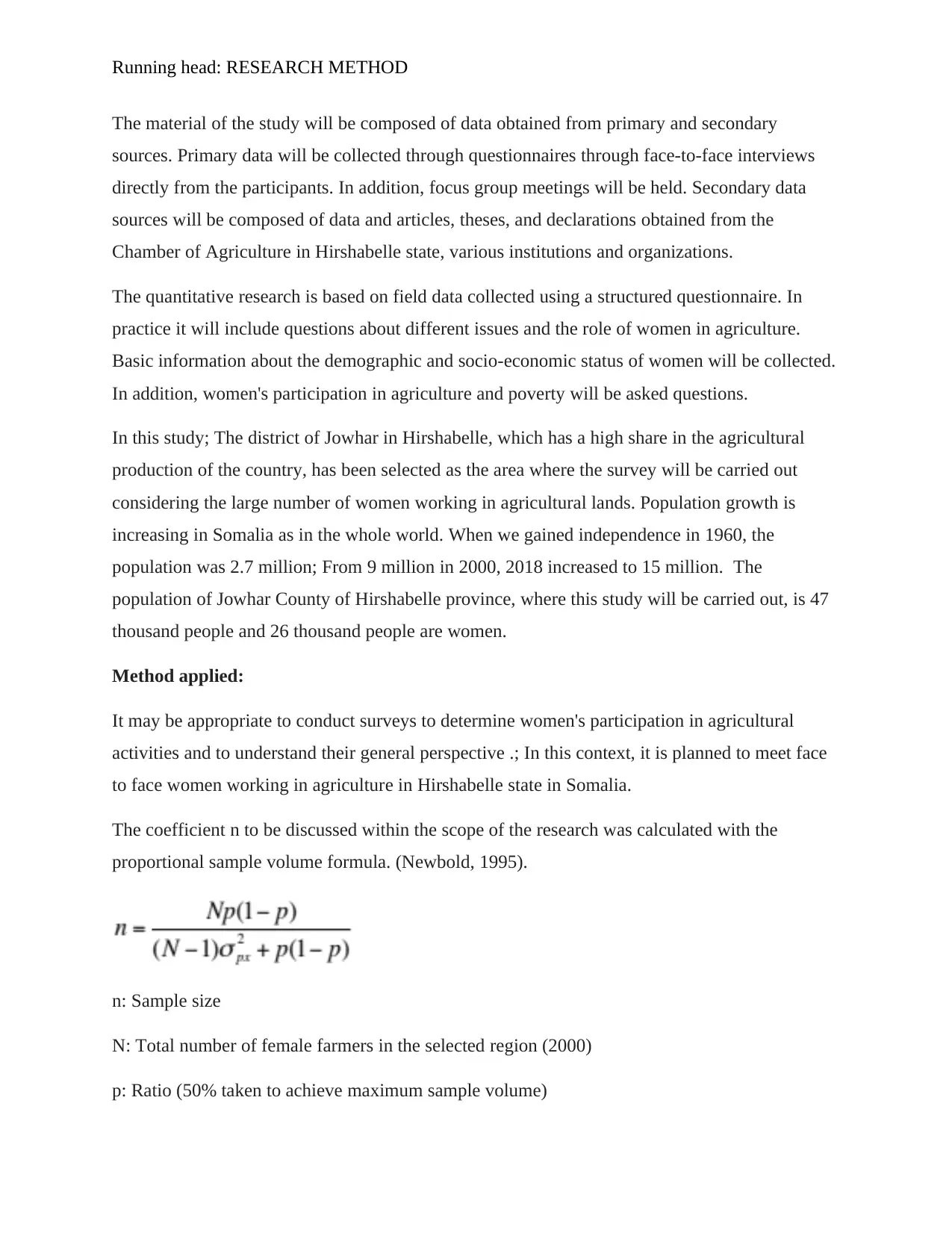
Running head: RESEARCH METHOD
The material of the study will be composed of data obtained from primary and secondary
sources. Primary data will be collected through questionnaires through face-to-face interviews
directly from the participants. In addition, focus group meetings will be held. Secondary data
sources will be composed of data and articles, theses, and declarations obtained from the
Chamber of Agriculture in Hirshabelle state, various institutions and organizations.
The quantitative research is based on field data collected using a structured questionnaire. In
practice it will include questions about different issues and the role of women in agriculture.
Basic information about the demographic and socio-economic status of women will be collected.
In addition, women's participation in agriculture and poverty will be asked questions.
In this study; The district of Jowhar in Hirshabelle, which has a high share in the agricultural
production of the country, has been selected as the area where the survey will be carried out
considering the large number of women working in agricultural lands. Population growth is
increasing in Somalia as in the whole world. When we gained independence in 1960, the
population was 2.7 million; From 9 million in 2000, 2018 increased to 15 million. The
population of Jowhar County of Hirshabelle province, where this study will be carried out, is 47
thousand people and 26 thousand people are women.
Method applied:
It may be appropriate to conduct surveys to determine women's participation in agricultural
activities and to understand their general perspective .; In this context, it is planned to meet face
to face women working in agriculture in Hirshabelle state in Somalia.
The coefficient n to be discussed within the scope of the research was calculated with the
proportional sample volume formula. (Newbold, 1995).
n: Sample size
N: Total number of female farmers in the selected region (2000)
p: Ratio (50% taken to achieve maximum sample volume)
The material of the study will be composed of data obtained from primary and secondary
sources. Primary data will be collected through questionnaires through face-to-face interviews
directly from the participants. In addition, focus group meetings will be held. Secondary data
sources will be composed of data and articles, theses, and declarations obtained from the
Chamber of Agriculture in Hirshabelle state, various institutions and organizations.
The quantitative research is based on field data collected using a structured questionnaire. In
practice it will include questions about different issues and the role of women in agriculture.
Basic information about the demographic and socio-economic status of women will be collected.
In addition, women's participation in agriculture and poverty will be asked questions.
In this study; The district of Jowhar in Hirshabelle, which has a high share in the agricultural
production of the country, has been selected as the area where the survey will be carried out
considering the large number of women working in agricultural lands. Population growth is
increasing in Somalia as in the whole world. When we gained independence in 1960, the
population was 2.7 million; From 9 million in 2000, 2018 increased to 15 million. The
population of Jowhar County of Hirshabelle province, where this study will be carried out, is 47
thousand people and 26 thousand people are women.
Method applied:
It may be appropriate to conduct surveys to determine women's participation in agricultural
activities and to understand their general perspective .; In this context, it is planned to meet face
to face women working in agriculture in Hirshabelle state in Somalia.
The coefficient n to be discussed within the scope of the research was calculated with the
proportional sample volume formula. (Newbold, 1995).
n: Sample size
N: Total number of female farmers in the selected region (2000)
p: Ratio (50% taken to achieve maximum sample volume)
Paraphrase This Document
Need a fresh take? Get an instant paraphrase of this document with our AI Paraphraser
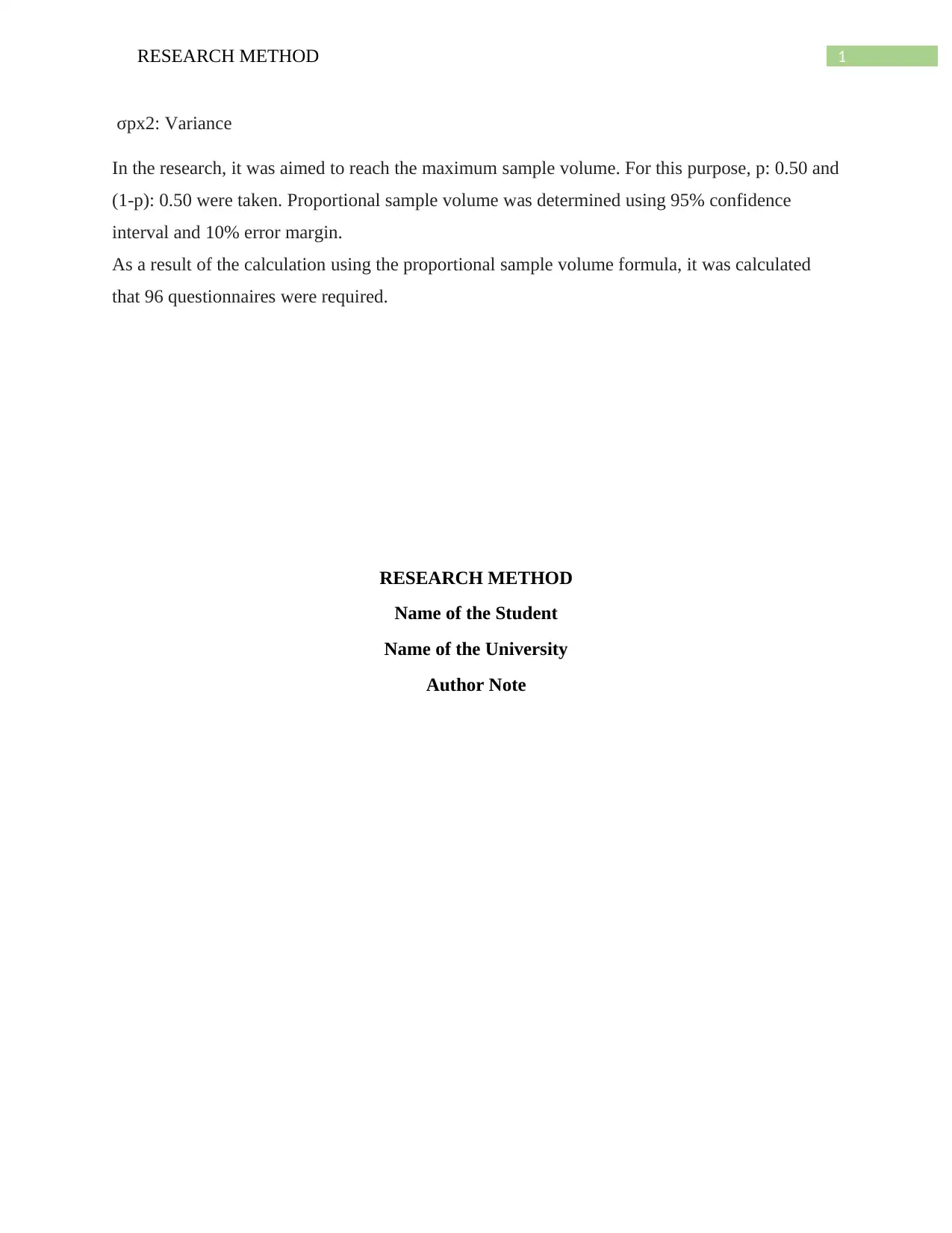
1RESEARCH METHOD
σpx2: Variance
In the research, it was aimed to reach the maximum sample volume. For this purpose, p: 0.50 and
(1-p): 0.50 were taken. Proportional sample volume was determined using 95% confidence
interval and 10% error margin.
As a result of the calculation using the proportional sample volume formula, it was calculated
that 96 questionnaires were required.
RESEARCH METHOD
Name of the Student
Name of the University
Author Note
σpx2: Variance
In the research, it was aimed to reach the maximum sample volume. For this purpose, p: 0.50 and
(1-p): 0.50 were taken. Proportional sample volume was determined using 95% confidence
interval and 10% error margin.
As a result of the calculation using the proportional sample volume formula, it was calculated
that 96 questionnaires were required.
RESEARCH METHOD
Name of the Student
Name of the University
Author Note
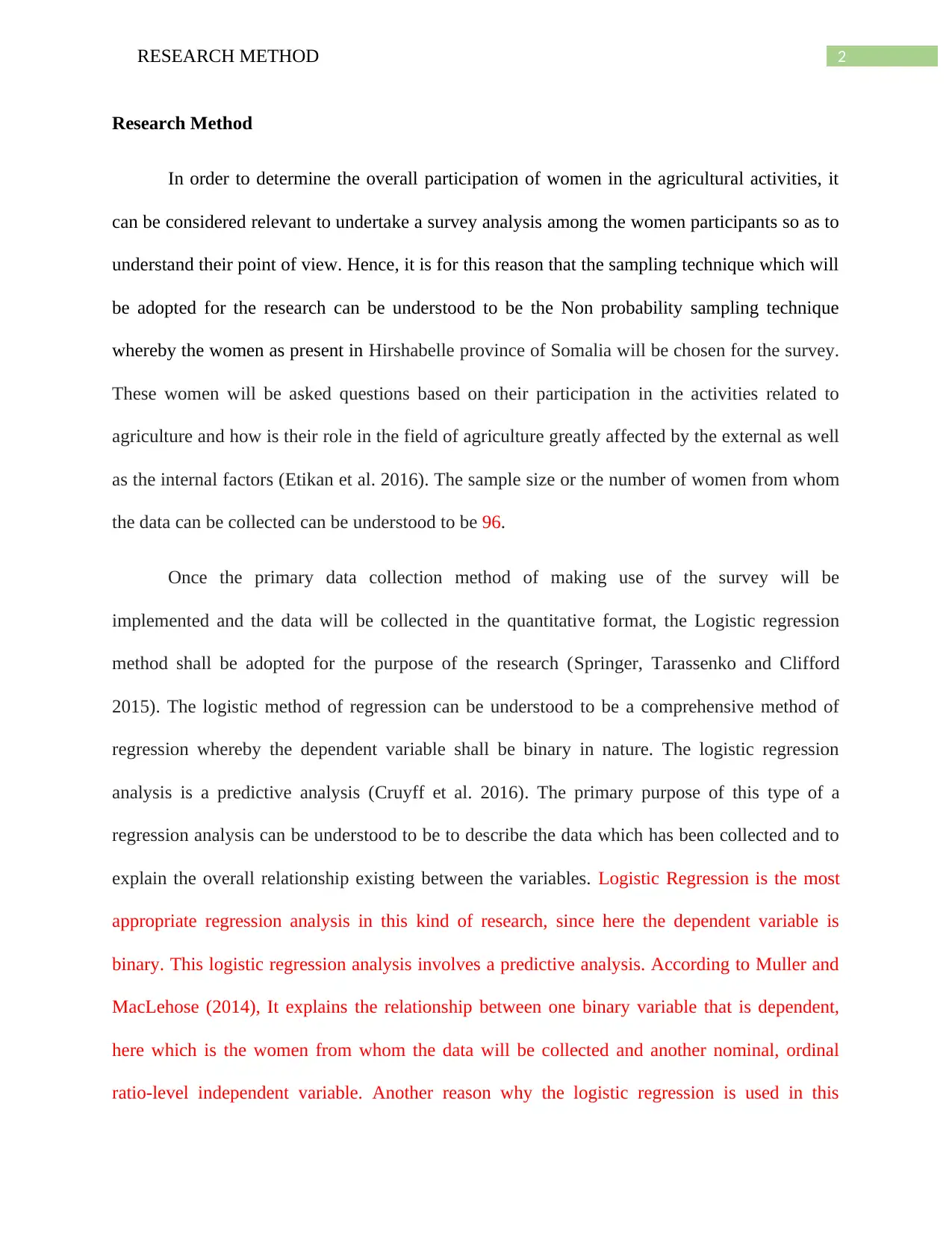
2RESEARCH METHOD
Research Method
In order to determine the overall participation of women in the agricultural activities, it
can be considered relevant to undertake a survey analysis among the women participants so as to
understand their point of view. Hence, it is for this reason that the sampling technique which will
be adopted for the research can be understood to be the Non probability sampling technique
whereby the women as present in Hirshabelle province of Somalia will be chosen for the survey.
These women will be asked questions based on their participation in the activities related to
agriculture and how is their role in the field of agriculture greatly affected by the external as well
as the internal factors (Etikan et al. 2016). The sample size or the number of women from whom
the data can be collected can be understood to be 96.
Once the primary data collection method of making use of the survey will be
implemented and the data will be collected in the quantitative format, the Logistic regression
method shall be adopted for the purpose of the research (Springer, Tarassenko and Clifford
2015). The logistic method of regression can be understood to be a comprehensive method of
regression whereby the dependent variable shall be binary in nature. The logistic regression
analysis is a predictive analysis (Cruyff et al. 2016). The primary purpose of this type of a
regression analysis can be understood to be to describe the data which has been collected and to
explain the overall relationship existing between the variables. Logistic Regression is the most
appropriate regression analysis in this kind of research, since here the dependent variable is
binary. This logistic regression analysis involves a predictive analysis. According to Muller and
MacLehose (2014), It explains the relationship between one binary variable that is dependent,
here which is the women from whom the data will be collected and another nominal, ordinal
ratio-level independent variable. Another reason why the logistic regression is used in this
Research Method
In order to determine the overall participation of women in the agricultural activities, it
can be considered relevant to undertake a survey analysis among the women participants so as to
understand their point of view. Hence, it is for this reason that the sampling technique which will
be adopted for the research can be understood to be the Non probability sampling technique
whereby the women as present in Hirshabelle province of Somalia will be chosen for the survey.
These women will be asked questions based on their participation in the activities related to
agriculture and how is their role in the field of agriculture greatly affected by the external as well
as the internal factors (Etikan et al. 2016). The sample size or the number of women from whom
the data can be collected can be understood to be 96.
Once the primary data collection method of making use of the survey will be
implemented and the data will be collected in the quantitative format, the Logistic regression
method shall be adopted for the purpose of the research (Springer, Tarassenko and Clifford
2015). The logistic method of regression can be understood to be a comprehensive method of
regression whereby the dependent variable shall be binary in nature. The logistic regression
analysis is a predictive analysis (Cruyff et al. 2016). The primary purpose of this type of a
regression analysis can be understood to be to describe the data which has been collected and to
explain the overall relationship existing between the variables. Logistic Regression is the most
appropriate regression analysis in this kind of research, since here the dependent variable is
binary. This logistic regression analysis involves a predictive analysis. According to Muller and
MacLehose (2014), It explains the relationship between one binary variable that is dependent,
here which is the women from whom the data will be collected and another nominal, ordinal
ratio-level independent variable. Another reason why the logistic regression is used in this
⊘ This is a preview!⊘
Do you want full access?
Subscribe today to unlock all pages.

Trusted by 1+ million students worldwide
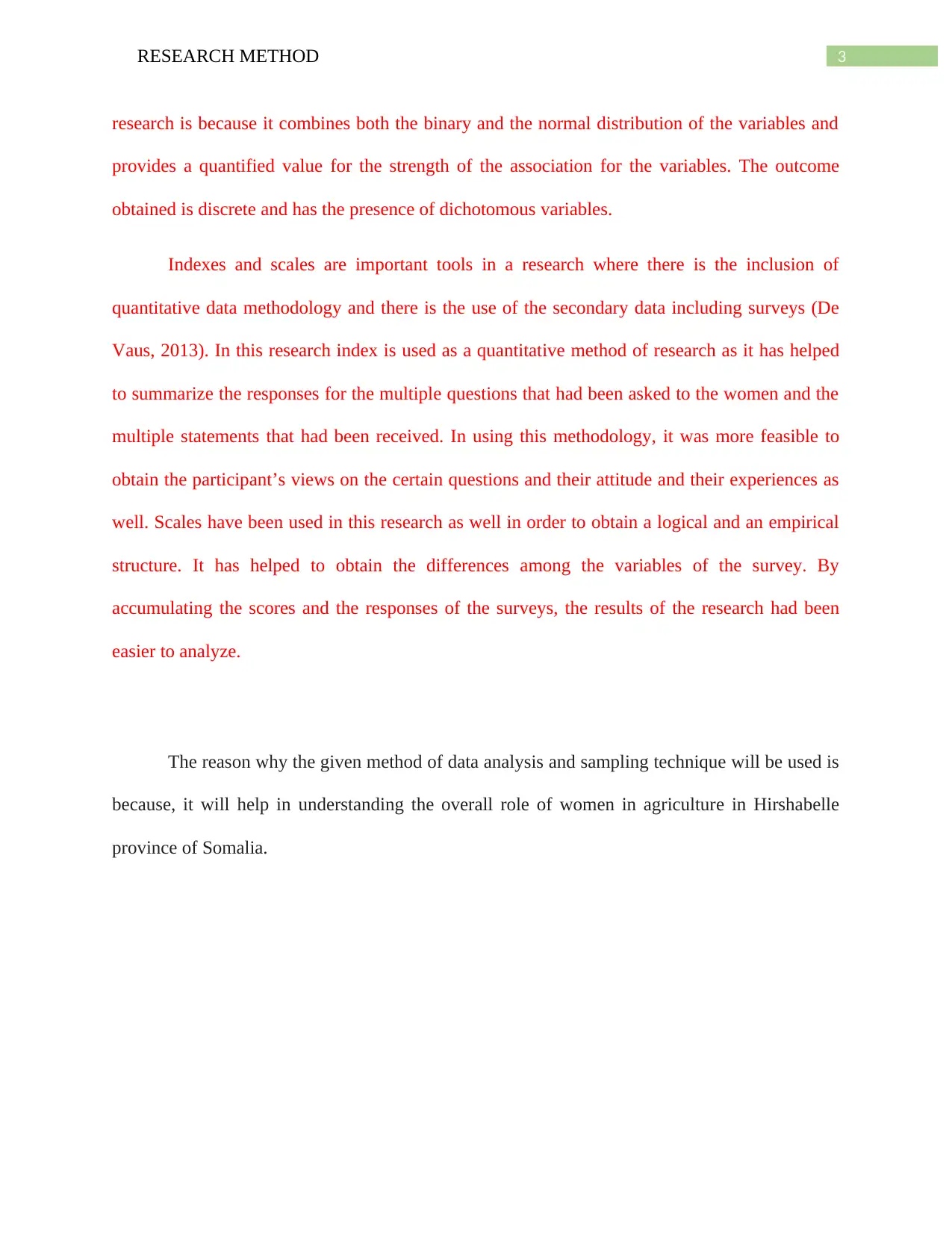
3RESEARCH METHOD
research is because it combines both the binary and the normal distribution of the variables and
provides a quantified value for the strength of the association for the variables. The outcome
obtained is discrete and has the presence of dichotomous variables.
Indexes and scales are important tools in a research where there is the inclusion of
quantitative data methodology and there is the use of the secondary data including surveys (De
Vaus, 2013). In this research index is used as a quantitative method of research as it has helped
to summarize the responses for the multiple questions that had been asked to the women and the
multiple statements that had been received. In using this methodology, it was more feasible to
obtain the participant’s views on the certain questions and their attitude and their experiences as
well. Scales have been used in this research as well in order to obtain a logical and an empirical
structure. It has helped to obtain the differences among the variables of the survey. By
accumulating the scores and the responses of the surveys, the results of the research had been
easier to analyze.
The reason why the given method of data analysis and sampling technique will be used is
because, it will help in understanding the overall role of women in agriculture in Hirshabelle
province of Somalia.
research is because it combines both the binary and the normal distribution of the variables and
provides a quantified value for the strength of the association for the variables. The outcome
obtained is discrete and has the presence of dichotomous variables.
Indexes and scales are important tools in a research where there is the inclusion of
quantitative data methodology and there is the use of the secondary data including surveys (De
Vaus, 2013). In this research index is used as a quantitative method of research as it has helped
to summarize the responses for the multiple questions that had been asked to the women and the
multiple statements that had been received. In using this methodology, it was more feasible to
obtain the participant’s views on the certain questions and their attitude and their experiences as
well. Scales have been used in this research as well in order to obtain a logical and an empirical
structure. It has helped to obtain the differences among the variables of the survey. By
accumulating the scores and the responses of the surveys, the results of the research had been
easier to analyze.
The reason why the given method of data analysis and sampling technique will be used is
because, it will help in understanding the overall role of women in agriculture in Hirshabelle
province of Somalia.
Paraphrase This Document
Need a fresh take? Get an instant paraphrase of this document with our AI Paraphraser
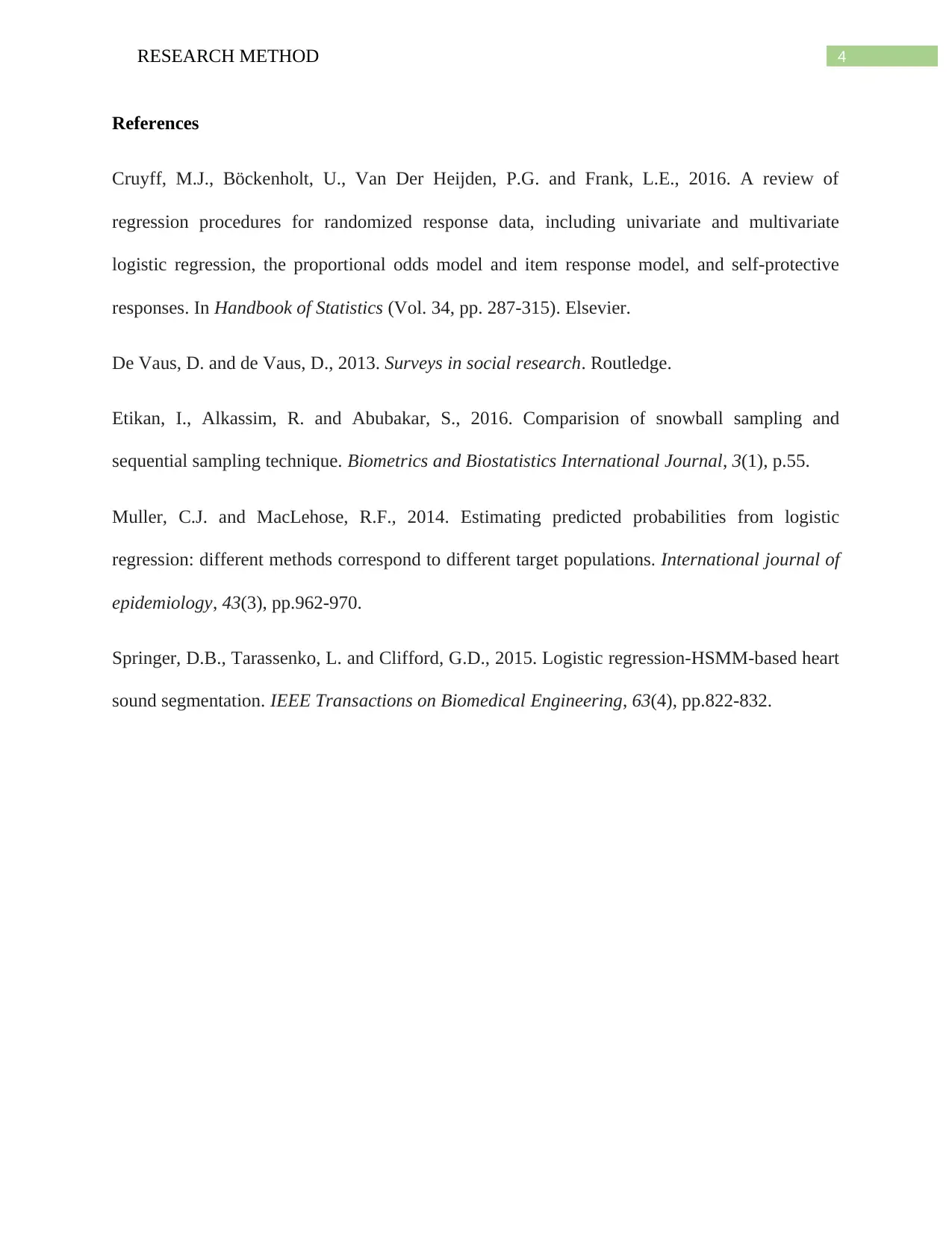
4RESEARCH METHOD
References
Cruyff, M.J., Böckenholt, U., Van Der Heijden, P.G. and Frank, L.E., 2016. A review of
regression procedures for randomized response data, including univariate and multivariate
logistic regression, the proportional odds model and item response model, and self-protective
responses. In Handbook of Statistics (Vol. 34, pp. 287-315). Elsevier.
De Vaus, D. and de Vaus, D., 2013. Surveys in social research. Routledge.
Etikan, I., Alkassim, R. and Abubakar, S., 2016. Comparision of snowball sampling and
sequential sampling technique. Biometrics and Biostatistics International Journal, 3(1), p.55.
Muller, C.J. and MacLehose, R.F., 2014. Estimating predicted probabilities from logistic
regression: different methods correspond to different target populations. International journal of
epidemiology, 43(3), pp.962-970.
Springer, D.B., Tarassenko, L. and Clifford, G.D., 2015. Logistic regression-HSMM-based heart
sound segmentation. IEEE Transactions on Biomedical Engineering, 63(4), pp.822-832.
References
Cruyff, M.J., Böckenholt, U., Van Der Heijden, P.G. and Frank, L.E., 2016. A review of
regression procedures for randomized response data, including univariate and multivariate
logistic regression, the proportional odds model and item response model, and self-protective
responses. In Handbook of Statistics (Vol. 34, pp. 287-315). Elsevier.
De Vaus, D. and de Vaus, D., 2013. Surveys in social research. Routledge.
Etikan, I., Alkassim, R. and Abubakar, S., 2016. Comparision of snowball sampling and
sequential sampling technique. Biometrics and Biostatistics International Journal, 3(1), p.55.
Muller, C.J. and MacLehose, R.F., 2014. Estimating predicted probabilities from logistic
regression: different methods correspond to different target populations. International journal of
epidemiology, 43(3), pp.962-970.
Springer, D.B., Tarassenko, L. and Clifford, G.D., 2015. Logistic regression-HSMM-based heart
sound segmentation. IEEE Transactions on Biomedical Engineering, 63(4), pp.822-832.

5RESEARCH METHOD
⊘ This is a preview!⊘
Do you want full access?
Subscribe today to unlock all pages.

Trusted by 1+ million students worldwide
1 out of 6
Your All-in-One AI-Powered Toolkit for Academic Success.
+13062052269
info@desklib.com
Available 24*7 on WhatsApp / Email
![[object Object]](/_next/static/media/star-bottom.7253800d.svg)
Unlock your academic potential
Copyright © 2020–2025 A2Z Services. All Rights Reserved. Developed and managed by ZUCOL.


